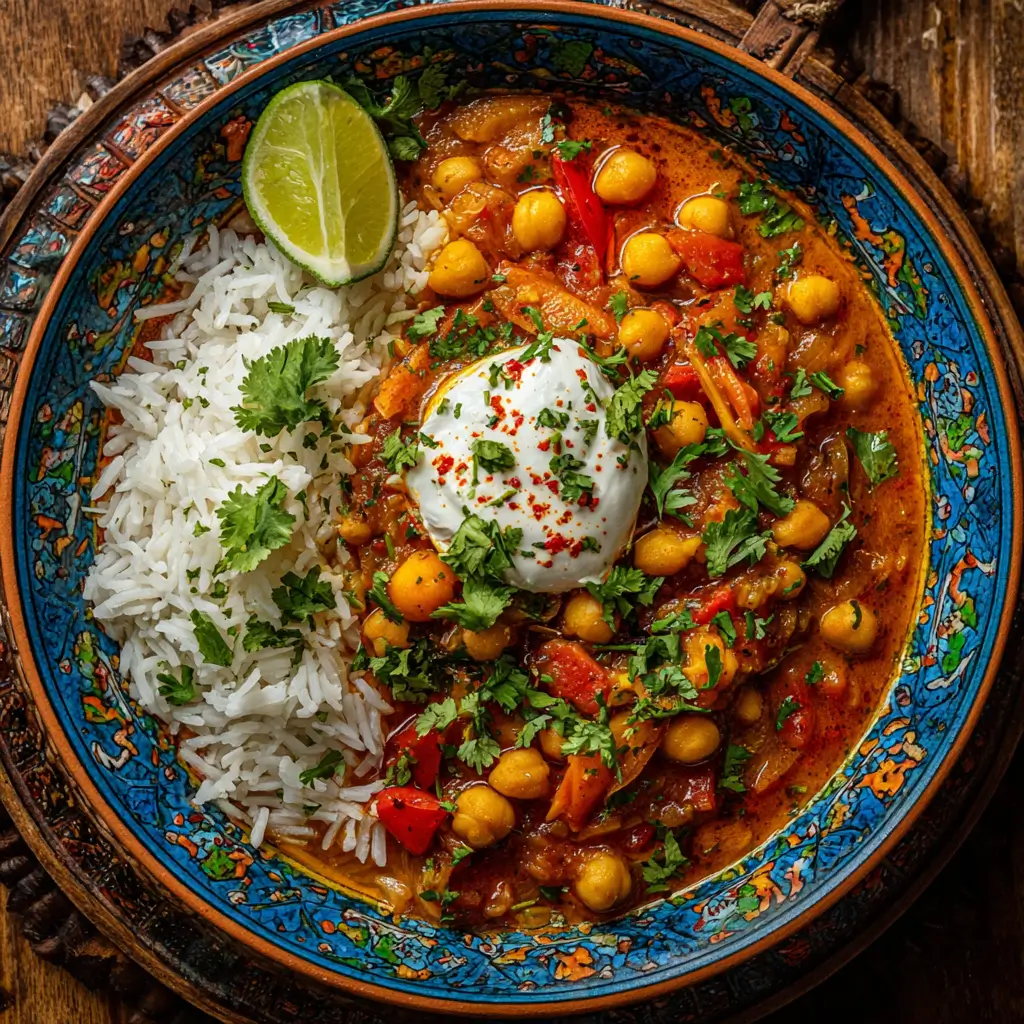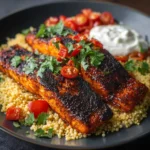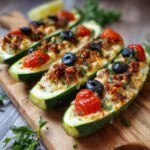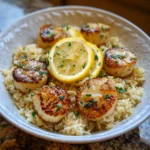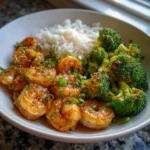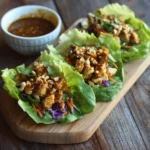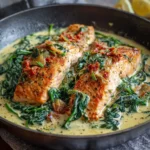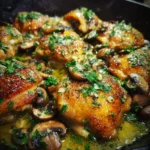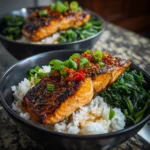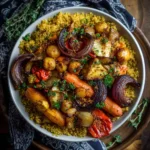Moroccan Chickpea Curry with Rice: A Flavorful Journey Through North African Cuisine
The History of Moroccan Chickpea Curry
Moroccan cuisine is a rich tapestry woven from centuries of cultural exchange, trade, and tradition. Rooted in Berber, Arab, Andalusian, and Mediterranean influences, Moroccan food reflects the country’s diverse geography and history. The use of chickpeas in Moroccan cooking dates back thousands of years, as they were a staple legume cultivated throughout North Africa due to their adaptability to arid climates and high nutritional value.
Chickpea-based dishes have long been central to Moroccan home cooking, especially among rural communities where plant-based proteins were essential for sustenance. One of the most beloved iterations is chickpea curry, known locally in various forms such as Dolma Makhlouk or Taktouka bil Hommos. While not always labeled “curry” in Morocco—since the term is more commonly associated with South Asian cuisine—the concept of slow-cooked spiced stews made with legumes, vegetables, and aromatic spices closely mirrors what Western palates recognize as curry.
This dish evolved further through trans-Saharan trade routes that introduced spices like cumin, coriander, turmeric, cinnamon, and ginger into Moroccan kitchens. These warm, earthy flavors became foundational to many savory preparations, including tagines and soups. Over time, Moroccans developed complex spice blends such as Ras el Hanout, meaning “top of the shop,” which symbolizes a master spice mix crafted by skilled merchants. Such blends are often used in chickpea dishes to elevate depth and complexity.
In modern times, Moroccan chickpea curry has gained international acclaim as part of the global movement toward plant-forward, sustainable eating. Its hearty texture, robust flavor profile, and compatibility with rice or couscous make it an ideal comfort meal enjoyed across continents. Whether served during Ramadan, family gatherings, or weekly meals, this dish continues to represent hospitality, nourishment, and culinary artistry in Moroccan culture.
Ingredients Breakdown: What Makes This Dish Shine?
The magic of Moroccan chickpea curry lies in its harmonious blend of ingredients—each contributing distinct textures, aromas, and health benefits. Below is a detailed breakdown of every component used in crafting this exquisite dish:
- Chickpeas (Garbanzo Beans): The star ingredient, packed with protein, fiber, and iron. Canned chickpeas offer convenience, while dried ones provide a creamier texture when soaked and cooked slowly.
- Basmati Rice: Long-grain fragrant rice that complements the curry with its light, fluffy consistency and subtle floral aroma. It acts as the perfect canvas for absorbing the rich sauce.
- Olive Oil: High-quality extra virgin olive oil adds richness and helps bloom the spices, enhancing their volatile compounds for maximum flavor release.
- Onions: Yellow or red onions form the aromatic base, caramelizing slightly to add sweetness and depth.
- Garlic: Fresh garlic cloves bring pungency and warmth, essential for building layers of flavor.
- Ginger: Freshly grated ginger offers a zesty, slightly spicy kick that balances the earthiness of other spices.
- Tomatoes: Diced canned tomatoes or fresh ripe tomatoes provide acidity and body to the stew, helping create a luscious sauce.
- Vegetable Broth: Enhances moisture and umami; using homemade broth deepens the savoriness without overpowering the spices.
- Lemon Juice: A splash brightens the entire dish, cutting through richness and elevating the overall taste.
- Fresh Herbs: Cilantro and parsley are traditionally used—cilantro adds citrusy freshness, while flat-leaf parsley contributes a mild bitterness and color.
- Spices: The soul of the dish. Key players include:
- Ground Cumin: Earthy and warm, evokes desert landscapes.
- Ground Coriander: Citrusy and floral, balances heavier notes.
- Turmeric: Adds golden hue and anti-inflammatory properties.
- Paprika (sweet or smoked): Contributes color and subtle smokiness.
- Cinnamon: A pinch lends warmth and unexpected sweetness, typical in Moroccan savory dishes.
- Cayenne Pepper (optional): For heat lovers, just a dash can ignite the palate.
- Ras el Hanout: A signature Moroccan blend that may contain up to 30 different spices, including cardamom, nutmeg, allspice, mace, and rose petals.
- Saffron (Optional but Luxurious): Soaked in warm water, saffron threads infuse the curry with a delicate perfume and golden glow, historically prized in royal Moroccan kitchens.
- Preserved Lemons (Traditional Addition): Fermented lemon peels add intense tang and umami, a hallmark of authentic Moroccan flavor.
- Olives (Green or Kalamata): Sometimes added towards the end for briny contrast, especially in coastal regions.
Step-by-Step Recipe: How to Make Authentic Moroccan Chickpea Curry with Rice
Ingredients for the Chickpea Curry:
- 2 tablespoons extra virgin olive oil
- 1 large yellow onion, finely chopped
- 4 garlic cloves, minced
- 1 tablespoon fresh ginger, grated
- 1 teaspoon ground cumin
- 1 teaspoon ground coriander
- 1/2 teaspoon ground turmeric
- 1/2 teaspoon sweet paprika
- 1/4 teaspoon ground cinnamon
- 1/8 teaspoon cayenne pepper (adjust to taste)
- 1 teaspoon Ras el Hanout (homemade or store-bought)
- 1 (14.5 oz) can diced tomatoes (preferably fire-roasted)
- 2 (15 oz) cans chickpeas, drained and rinsed (or 3 cups cooked dried chickpeas)
- 1 1/2 cups vegetable broth
- 1 tablespoon tomato paste (optional, for thicker sauce)
- 1 preserved lemon, pulp removed, peel rinsed and finely chopped (optional)
- 1/2 cup green olives, pitted and halved (optional)
- Juice of 1 lemon
- Salt and freshly ground black pepper, to taste
- 1/4 cup fresh cilantro, chopped
- 1/4 cup fresh parsley, chopped
- A few saffron threads steeped in 2 tbsp warm water (optional)
For Serving:
- 1 1/2 cups basmati rice
- 3 cups water or vegetable broth
- Pinch of salt
- Lemon wedges
- Extra herbs for garnish
- Yogurt or dairy-free alternative (for cooling contrast)
Directions:
- Prepare the Rice: Rinse basmati rice under cold water until the water runs clear. In a medium pot, combine rice, water or broth, and a pinch of salt. Bring to a boil, then reduce heat to low, cover, and simmer for 15–18 minutes until tender and fluffy. Remove from heat and let sit covered for 5 minutes. Fluff with a fork before serving.
- Sauté Aromatics: In a large, heavy-bottomed pot or Dutch oven, heat olive oil over medium heat. Add chopped onions and cook for 6–8 minutes, stirring occasionally, until translucent and beginning to caramelize.
- Add Garlic and Ginger: Stir in minced garlic and grated ginger. Cook for 1 minute until fragrant, being careful not to burn.
- Bloom the Spices: Add cumin, coriander, turmeric, paprika, cinnamon, cayenne, and Ras el Hanout. Stir constantly for 30 seconds to toast the spices and release their essential oils. The kitchen should be filled with a warm, intoxicating aroma.
- Incorporate Tomatoes: Pour in the diced tomatoes (with juices) and tomato paste (if using). Stir well and cook for 4–5 minutes to break down the tomatoes and thicken slightly.
- Add Chickpeas and Liquid: Stir in the chickpeas, vegetable broth, saffron with its soaking liquid (if using), and preserved lemon (if using). Mix thoroughly to combine. Season lightly with salt—you’ll adjust later.
- Simmer Gently: Increase heat to bring the mixture to a gentle boil, then reduce to low. Cover partially and let the curry simmer for 25–30 minutes, stirring occasionally. This allows the flavors to meld and the sauce to thicken naturally.
- Add Olives (if using): Ten minutes before the end of cooking, stir in green olives for a pop of brininess.
- Finish with Freshness: Remove from heat. Stir in fresh lemon juice, chopped cilantro, and parsley. Taste and adjust seasoning—add more salt, lemon, or spices as needed.
- Serve Warm: Spoon the fluffy basmati rice onto plates or bowls. Ladle generous portions of the chickpea curry over the top. Garnish with additional herbs, lemon wedges, and a dollop of yogurt if desired.
Tips for Perfect Moroccan Chickpea Curry Every Time
- Toasting Spices is Crucial: Never skip blooming your spices in oil. This step unlocks their full potential and prevents a raw, powdery taste.
- Use Quality Olive Oil: Since it’s one of the first ingredients, opt for a good extra virgin olive oil with fruity notes to enhance the base flavor.
- Don’t Rush the Onions: Let them cook slowly to develop natural sweetness, which balances the tartness of tomatoes and lemon.
- Adjust Acidity: If the curry tastes flat, add a bit more lemon juice. If too sharp, a pinch of sugar or honey can round it out.
- Thicken the Sauce: For a richer texture, mash a small portion of chickpeas against the side of the pot with a spoon and stir back in.
- Rest Before Serving: Like many stews, this curry tastes even better after sitting for 10–15 minutes off the heat, allowing flavors to deepen.
- Reheat Gently: When reheating leftovers, do so on low with a splash of water or broth to revive the sauce.
- Make Ahead Friendly: This dish freezes beautifully for up to 3 months. Store in airtight containers and thaw overnight in the fridge.
Variations and Customizations
Moroccan chickpea curry is incredibly versatile and welcomes creative adaptations based on dietary preferences, seasonal produce, or regional twists:
- Vegetable-Packed Version: Add diced carrots, zucchini, bell peppers, or sweet potatoes during the sauté stage for extra nutrition and color.
- Spinach or Kale Addition: Stir in a couple of handfuls of chopped greens during the last 5 minutes of cooking for a boost of iron and vibrancy.
- Creamy Twist: For a silkier mouthfeel, stir in 1/4 cup coconut milk or cashew cream at the end.
- Protein Boost: While already high in plant protein, you can add crumbled feta, grilled tofu, or seitan cubes for added texture.
- Gluten-Free Option: Naturally gluten-free, just ensure your vegetable broth and spices are certified GF.
- Vegan & Dairy-Free: Already vegan-friendly! Use plant-based yogurt for serving.
- Slow Cooker Method: After sautéing onions, garlic, and spices, transfer everything to a slow cooker. Add remaining ingredients and cook on low for 6–8 hours or high for 3–4 hours.
- Instant Pot Version: Use Sauté function for aromatics and spices, then add all ingredients except herbs and lemon. Pressure cook on High for 10 minutes, natural release. Stir in fresh elements before serving.
- Serving Alternatives: Instead of rice, serve over couscous (traditional), quinoa, millet, or with warm pita bread for dipping.
- Smoky Variation: Add a pinch of smoked paprika or a drop of liquid smoke for a deeper, campfire-like essence.
- Dessert Fusion: For a festive twist, serve with a side of orange slices sprinkled with cinnamon—a common Moroccan dessert pairing.
Health Considerations and Nutritional Value
Moroccan chickpea curry is not only delicious but also highly nutritious, making it a powerhouse meal for those seeking balanced, wholesome eating.
Nutritional Highlights (per serving, approx. 1 1/2 cups curry + 3/4 cup rice):
- Calories: ~400–450 kcal
- Protein: ~12–15g (excellent plant-based source)
- Fiber: ~10–12g (supports digestion and satiety)
- Carbohydrates: ~70–75g (complex carbs from legumes and whole grains)
- Fat: ~10–12g (mostly heart-healthy monounsaturated fats from olive oil)
- Iron: ~25% of daily value (important for energy and oxygen transport)
- Folate: ~60% DV (crucial for cell function and tissue growth)
- Manganese, Phosphorus, Copper: Significant amounts from chickpeas
- Antioxidants: From tomatoes (lycopene), turmeric (curcumin), and spices
Health Benefits:
- Supports Heart Health: Low in saturated fat and rich in fiber, potassium, and antioxidants.
- Blood Sugar Regulation: The combination of fiber, protein, and low glycemic index ingredients helps stabilize glucose levels.
- Anti-Inflammatory Properties: Turmeric and ginger are potent anti-inflammatory agents linked to reduced chronic disease risk.
- Digestive Wellness: High fiber content promotes gut health and regularity.
- Weight Management: Filling and satisfying without excessive calories, ideal for plant-based diets.
- Immune Support: Vitamin C from lemon, zinc from chickpeas, and immune-modulating spices contribute to resilience.
Dietary Notes:
- Perfect for vegans, vegetarians, and flexitarians.
- Gluten-free adaptable (ensure no cross-contamination).
- Low in cholesterol and sodium (especially if using low-sodium broth).
- Rich in phytonutrients and polyphenols from herbs and spices.
Frequently Asked Questions (FAQ)
Can I use dried chickpeas instead of canned?
Absolutely! Soak 1 cup of dried chickpeas overnight in plenty of water. Drain, then boil in fresh water for 1–1.5 hours until tender. You’ll get about 2.5–3 cups cooked, perfect for this recipe. Dried chickpeas tend to be creamier and less metallic in taste.
Is Ras el Hanout necessary?
While optional, it adds authenticity and complexity. If unavailable, increase cumin, coriander, and cinnamon slightly, or add a pinch of allspice or cardamom. However, investing in a quality blend elevates the dish significantly.
How long does it keep in the fridge?
The curry will stay fresh in an airtight container for 4–5 days. In fact, many say it tastes better the next day as the flavors continue to meld.
Can I freeze this dish?
Yes! Freeze in portion-sized containers for up to 3 months. Thaw in the refrigerator overnight and reheat gently on the stove with a splash of liquid.
Why is my curry too thin or too thick?
If too thin, simmer uncovered longer to reduce. If too thick, stir in warm broth or water a tablespoon at a time until desired consistency is reached.
Are preserved lemons essential?
No, but they add a unique tang that defines traditional Moroccan flavor. Substitute with zest of one lemon + 1 tsp lemon juice if unavailable.
Can I make this oil-free?
Yes, for an oil-free version, sauté onions and spices in water or broth. Note: spice blooming won’t be as pronounced, so consider adding a touch more spice.
What can I serve with this curry?
Classic pairings include warm pita, flatbread, hummus, baba ganoush, cucumber-tomato salad, or a simple harissa drizzle for heat lovers.
Summary
Moroccan Chickpea Curry with Rice is a vibrant, nutrient-dense dish that celebrates the soul of North African cuisine through aromatic spices, tender legumes, and fragrant basmati rice. Hearty yet healthy, it’s a meal that nourishes both body and spirit.
Whether you’re exploring plant-based cooking, seeking comfort food with global flair, or simply craving bold flavors, this curry delivers an unforgettable experience with every bite—warm, welcoming, and deeply satisfying.
